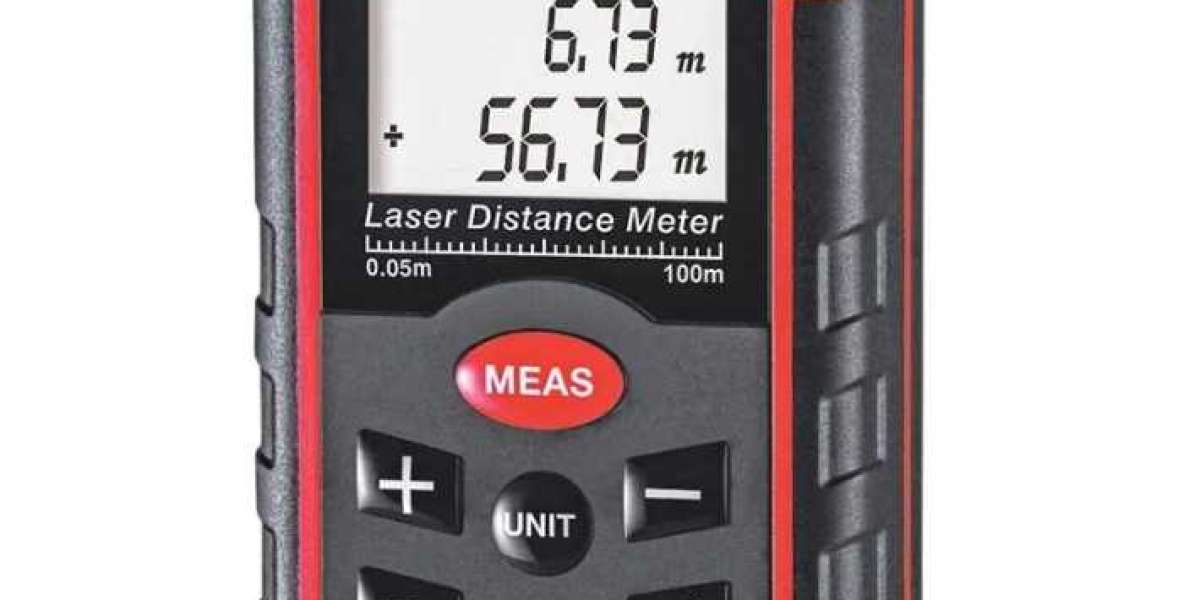Laser measuring device have significantly reshaped the way we approach measurements in various industries, from construction and real estate to interior design and engineering. These devices, leveraging cutting-edge technology, offer unmatched accuracy, speed, and versatility. But what makes them stand out in comparison to traditional measuring tools like tape measures or rulers?
The key lies in the principles of laser technology itself. A laser measuring device works by emitting a laser beam toward a target. When the beam hits the target, it reflects back to the device's sensor. By calculating the time it takes for the light to travel to the target and back, the device determines the distance with remarkable precision. This method, known as time-of-flight (ToF), or phase-shift technology, allows for quick and accurate measurements over both short and long distances.
Precision and Accuracy
One of the primary reasons a laser measuring device is considered a game changer is the precision it offers. Traditional tools often leave room for human error, especially over large distances or in situations that require exact measurements. A slight misstep with a tape measure, for example, could lead to substantial discrepancies. In contrast, a laser measuring device can give precise readings to the millimeter, minimizing errors that could otherwise affect the success of a project. Whether you're measuring the height of a building or the length of a piece of furniture, the laser measuring device provides confidence in the accuracy of the results.
This high level of precision is particularly useful in industries like construction and architecture, where even the smallest measurement mistakes can have costly consequences. The integration of laser technology into measurement tools eliminates those risks, enabling more reliable results across various applications.
Versatility Across Applications
While laser measuring devices are often associated with construction, their versatility extends far beyond this field. Professionals in engineering, interior design, and surveying also rely heavily on laser measuring tools. For example, in interior design, accurate measurements are essential for ensuring furniture and decor fit perfectly within a space. A laser measuring device can quickly assess wall lengths, ceiling heights, and even the distance between objects, helping designers and architects work more efficiently.
In surveying and civil engineering, laser distance meters enable professionals to take measurements in difficult-to-reach areas or across vast expanses without the need for multiple workers or complex setups. Whether you're working indoors or outdoors, laser measuring tools can provide measurements from hundreds of meters away, making them indispensable for both small-scale and large-scale projects.
Furthermore, laser measuring devices can easily handle irregular shapes or uneven surfaces, something that traditional measuring methods often struggle with. For instance, measuring across a room's vaulted ceiling or around obstacles like furniture can be challenging without the right tools. A laser measuring device simplifies this process by providing quick measurements without the need for physically maneuvering around objects or relying on inaccurate manual calculations.
Speed and Efficiency
Another significant advantage of laser measuring devices is their speed. Traditional methods of measuring, such as using a tape measure, can be time-consuming, especially when trying to measure long distances or multiple areas within a given space. A tape measure requires constant adjustment, and the process can be slow, particularly if the measurement involves multiple measurements at different points.
In contrast, laser measuring devices can provide instantaneous readings, eliminating the need for manual handling and significantly improving efficiency. A laser measuring device can typically take readings in less than a second, which makes it ideal for environments where time is of the essence. Whether you're working on a construction site where every minute counts or trying to measure multiple rooms for a real estate project, these devices ensure that you can complete tasks faster without compromising on accuracy.
Moreover, advanced laser measuring devices often include features like built-in memory to store previous measurements, which further enhances efficiency during a project. This functionality allows professionals to work seamlessly without having to write down or re-enter measurements repeatedly. In addition, some models come with Bluetooth or other wireless capabilities, enabling easy transfer of measurement data directly to mobile devices or computers. This integration into digital workflows is an essential tool for professionals working on large-scale projects.
Easy to Use
While laser measuring devices are sophisticated in terms of technology, they are also designed to be incredibly user-friendly. Most devices have simple, intuitive interfaces that make them accessible even for those who are not highly technical. You typically only need to point the device at the target, press a button, and the measurement is displayed on a digital screen in an instant. This simplicity allows users to take precise measurements without needing specialized training.
In fact, some laser measuring devices come with additional functionalities, such as continuous measurement modes, area calculation modes, and even Pythagorean theorem capabilities, which help users calculate indirect distances. These features, though advanced, are often integrated in such a way that they don't overwhelm the user. The result is a tool that balances sophisticated technology with ease of use.
The convenience and simplicity of using laser measuring tools are one of the key reasons they have gained widespread adoption in a variety of fields. Whether you're measuring the dimensions of a room, verifying the height of a building, or calculating the distance between objects in a landscape, a laser measuring device can provide a streamlined solution without requiring extensive technical knowledge.
Portability and Compact Design
Modern laser measuring devices are designed to be lightweight, portable, and easy to carry around. Whether you're on a job site or moving between different locations, a compact laser measuring tool can be easily transported in a bag or tool pouch. This portability allows professionals to carry the device with them throughout the day, making it readily available when a quick measurement is needed.
The compact design also makes it ideal for measuring in tight spaces or hard-to-reach areas where traditional tools would be cumbersome. For example, when working in narrow hallways or small rooms, a tape measure can be unwieldy, and it can be difficult to hold and measure at the same time. A laser measuring device, on the other hand, allows users to measure from a distance, providing flexibility without the need for physical movement or extensive space.
Reducing Human Error
Human error is inevitable in any manual task, but it becomes especially problematic when precise measurements are needed. Even the most experienced workers can make mistakes when measuring manually. A miscalculation, a bent tape, or an incorrectly aligned ruler can result in a significant error in the final measurement. This can lead to delays, increased costs, and even project failure.
A laser measuring device eliminates the risk of human error, providing reliable and repeatable results every time. The consistency of the measurements ensures that all involved parties can trust the data, which leads to smoother collaboration and greater confidence in the project's outcome.
Moreover, many laser measuring devices are designed to automatically adjust for various environmental factors, such as temperature or humidity, which can affect measurements. This built-in adaptability further ensures that users get accurate readings, even in less-than-ideal conditions.
Conclusion
The laser measuring device has fundamentally changed the way measurements are taken across various industries. Through its combination of precision, speed, versatility, and ease of use, it offers an ideal solution for professionals and DIY enthusiasts alike. Whether you're in construction, interior design, surveying, or any other field requiring accurate measurements, these devices can make the process faster, more efficient, and more reliable.
By eliminating human error, improving accuracy, and increasing productivity, the laser measuring device has proven itself to be an indispensable tool for those who demand high-quality results. With its advanced features, user-friendly interface, and portability, it's clear why laser measuring devices have become a game changer in the world of measurements.











